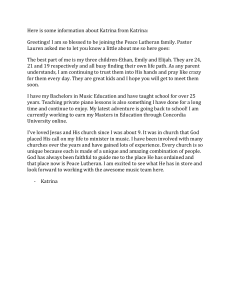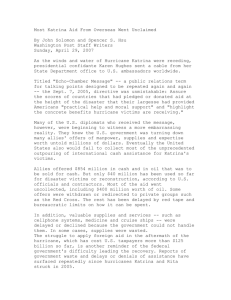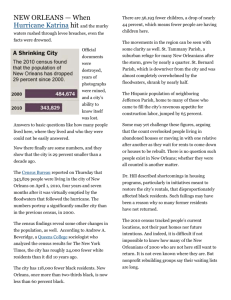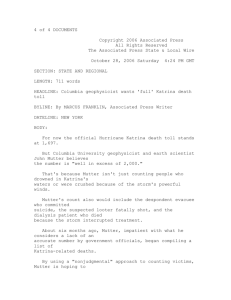Study tries to identify uncounted storm victims
advertisement
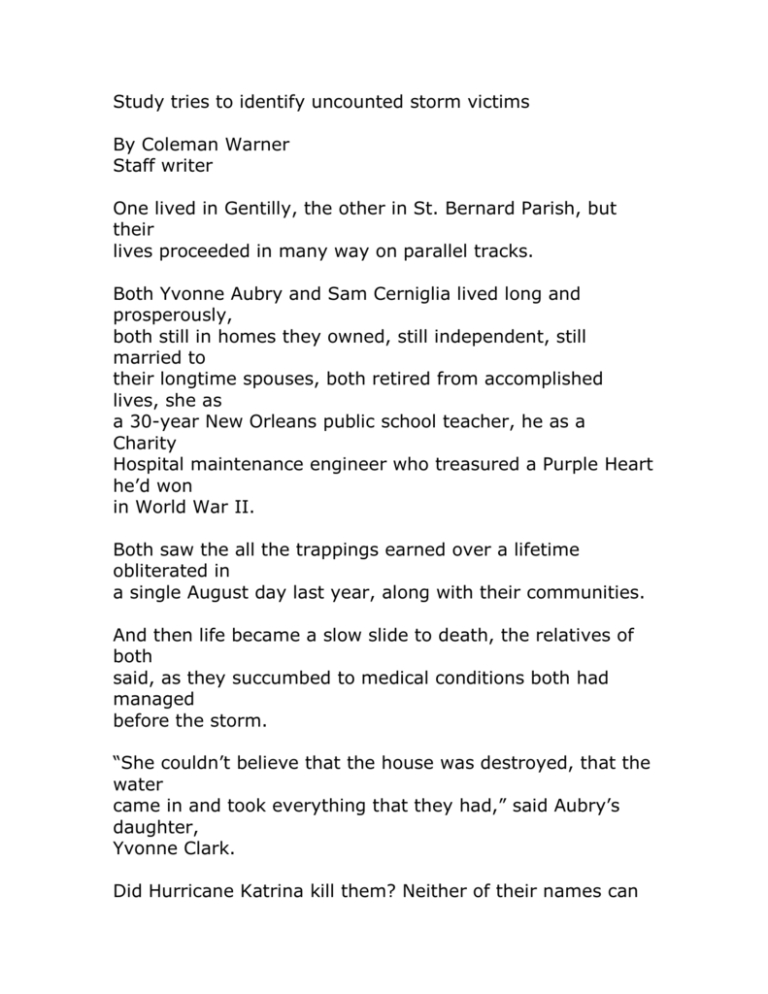
Study tries to identify uncounted storm victims By Coleman Warner Staff writer One lived in Gentilly, the other in St. Bernard Parish, but their lives proceeded in many way on parallel tracks. Both Yvonne Aubry and Sam Cerniglia lived long and prosperously, both still in homes they owned, still independent, still married to their longtime spouses, both retired from accomplished lives, she as a 30-year New Orleans public school teacher, he as a Charity Hospital maintenance engineer who treasured a Purple Heart he’d won in World War II. Both saw the all the trappings earned over a lifetime obliterated in a single August day last year, along with their communities. And then life became a slow slide to death, the relatives of both said, as they succumbed to medical conditions both had managed before the storm. “She couldn’t believe that the house was destroyed, that the water came in and took everything that they had,” said Aubry’s daughter, Yvonne Clark. Did Hurricane Katrina kill them? Neither of their names can be found on the official state list of flood-related deaths. And yet their stories hold particular interest for Columbia University professor John Mutter, who is gearing up an inquiry about far-flung Katrina victims. He relies on Internet searches and public feedback. He vows an almost indefinite committment to recording their deaths and, when possible, the details of their lives. “The sad thing about these events, not just in our country but all over the world, is people have short memories of these things. There’s a weariness in hearing about it,” Mutter said. “They get tired and they say ‘What’s the point with continuing on with the funding of these (identification efforts)?’ ” Mutter said that, based on preliminary findings, he believes hundreds of people could be legitimately added to Katrina’s death toll. State officials have vowed to work with him to improve Katrina-death identification work for which federal financing has run short. The New York environmental sciences professor and a research associate, Amatulla R’id, are using published stories and obituaries, Internet searches and, beginning this week, a Web site appeal, to develop leads or information about people who did, or may have, died as a result of Katrina. That includes people who succumbed to health problems, or committed suicide, long after the storm, or hundreds of miles away from the disaster zone. As deputy director of Columbia’s Earth Institute in New York, Mutter studies the “demography of vulnerability” in connection with people killed by natural disasters around the globe, and he is troubled by persistent gaps in data available about Katrina’s victims. “I keep thinking that somebody else must be doing this, but I keep finding out that nobody else is,” said Mutter, 58, who hasn’t visited the New Orleans area since Katrina. “The scale of the tragedy is measured in the death toll ... It’s very important to get as accurately as possible what the real number was.” It also is essential to learn more about victims already identified by government officials, who comprise the bulk of an official count of nearly 1,700 in Louisiana and Mississippi, Mutter says. The Louisiana Department of Health and Hospitals has documented the deaths of 1,464 people in or from southeast Louisiana as a result of the storm, and prior to Oct. 1. The agency also has a released a list of 828 victim names, drawn from bodies examined at federally-funded morgues set up after Katrina. The ramping up of the Columbia project comes amid frustration on the part of some state officials that federal financial support for a finer accounting of those killed by Katrina has tapered off. The Find Family National Call Center shut down weeks ago, and bureaucrats in Baton Rouge have shipped DNA samples off to a north Louisiana crime lab. Ezra Boyd, a researcher at the Louisiana State University Hurricane Center who is studying the geographic distribution of Katrina’s storm victims, said the work of the Columbia researchers probes a vital “grey area” of storm effects that so far has received little attention. “Take a million people, take away their homes” and temporarily disperse them, and all manner of fatal effect can be expected in the aftermath, he said. “I think a few hundred (unrecorded deaths) is possible.” Beyond the basics of age, race and gender, the researchers are asking relatives and friends to add information about marital status, location of death, dates of death and birth, employment, housing (renter or homeowner) at the time of the storm, and car ownership. Those responding also are asked their opinion about whether the victim died as a direct or indirect result of Katrina. The name and a phone number for those offering information is requested, but Mutter said he tries to avoid calling immediate family members, hoping not to cause them any emotional grief. Louisiana’s state medical examiner, Dr. Louis Cataldie, said the Columbia effort seems well crafted and that he will talk with Mutter to establish a link between the project and Louisiana agencies. But Cataldie noted that other Web sites gathering information about Katrina victims have come and gone, and he wondered if the Columbia effort will be short-lived. Mutter said he believes that within six months the flow of useful data will taper off. But he has no plans for shutting down the Web site and said his search for more information about victims will continue “essentially indefinitely.” Information is collected through the Earth Institute’s Web site and, after screening, it is posted on the site for public viewing. So far the researchers have assembled and posted information, with various levels of descriptive detail, on nearly 1,200 people. Some of the posted details are surprisingly personal. The first victim listed, for example, 64-year-old Wayne Aaslestad, a Lake Catherine resident — also included in the state’s official list of victims — is described on the Columbia Web site as “poor” under a social-status column, and, citing Web blogs and other sources, it adds: “From South Louisiana; grew up on St. Roch Avenue in Gentilly; sold his parents’ house in 1995; lived most of his life at his camp out on Highway 90, Chef Menteur Highway. His home rested atop pilings over Lake St. Catherine amidst an assortment of odd vehicles, including trucks and boats. He planted fig trees in his yard and grew tomatoes.” While most names are drawn from Louisiana and Mississippi official lists, many were hunted down through other sources. Some of those listed through the Web site, but not in records kept by the Louisiana Department of Health and Hospitals, already are well known as a result of tragic events after the storm. One is Sgt. Paul Accardo of the New Orleans Police Department, who committed suicide six days after the storm devastated the city. Others include hip-hop musician Jerome “Slim Rome” Spears and his fiancee Rachel Harris. After Katrina drove the two out of New Orleans, putting both out of work, Spears fatally shot Harris and then killed himself in January, at a rental home near Atlanta. Most of the victim names the Web site is uncovering aren’t well known. They include Cerniglia and Aubry, reluctant evacuees who, like thousands of others, thought they would soon be returning to tidy up their properties. Their children say there is little doubt that, while not listed on the death certificate, Katrina was the central event that brought about their deaths. Cerniglia’s son Ray his father and mother Dorothy bounced among the homes of relatives before taking up residence together at the Hammond Nursing Home, because they could no longer care for themselves. Both were distressed about the high cost of repairing their flooded home and fretted at being told they could not return there. “He kept asking about the house, everything like that,” Ray Cernigla said. “He couldn’t take care of her, she couldn’t take care of him.” Dorothy Cerniglia, 90, died June 4 at North Oaks Medical Center. Like her husband, she didn’t make it on the state’s list of Katrina victims, and she hasn’t yet made it onto Columbia’s. Grieving and wasting away physically, Sam Cerniglia, 84, died Aug. 8 at the nursing home. “A lot of elderly have died in the last year,” Ray Cerniglia said. “It was just too much stress on them.” That view is echoed by Yvonne Clark who, having lost her own eastern New Orleans home in the storm, struggled in Texas to help her parents after their evacuation there. The retired schoolteacher had faced a flurry of medical problems, including a stroke, and died Sept. 8 at Baylor Medical Center in Irving. Clark now focuses her concern on her father, retired Loyola University education professor Alvin Aubry. He grieves for his lost wife, can no longer live alone and misses New Orleans terribly, she said. “Right now, he’s in a skilled care facility because his diabetes was acting up,” the daughter said. “He would love to come home, but he can’t come home.” Coleman Warner can be reached at cwarner@timespicayune.com or at (504)826-3311.

